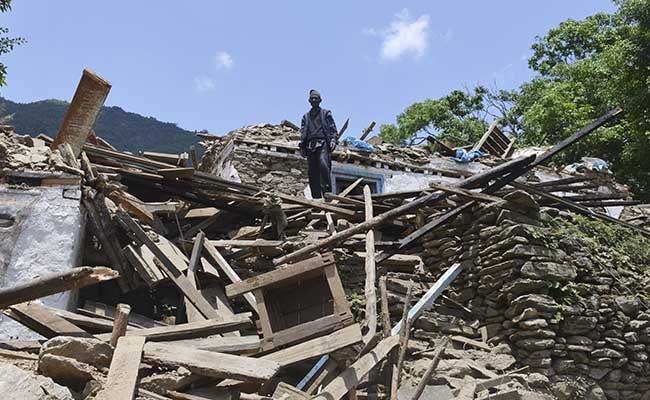
The Gorkha earthquake struck Nepal on April 25 last year. (File Photo)
Washington, United States:
The entire Himalayan region may be under the risk of earthquakes more devastating than last year's Nepal earthquake that killed over 8,000 people, due to the immense build-up of strain in the fault underlying the area, a new study has found.
The Gorkha earthquake struck Nepal on April 25 last year. It is a part of the world that is prone to earthquakes, as the Indian plate makes its incremental, sticky descent beneath the Eurasian plate.
The magnitude 7.8 jolt, which was very shallow (only 15 km underground), caused a tremendous damage in Kathmandu and other cities.
However, it did not rupture the Earth's surface, indicating that only part of the fault had slipped, below ground. Even the afterslip - post-earthquake movement - produced little surface evidence of continued movement.
That meant either the part of the fault that had not moved was experiencing a slow-slip event, a slow-motion earthquake, or it remained completely locked, accumulating further strain in that segment of the fault.
The new study from University of Colorado Boulder's Cooperative Institute for Research in Environmental Sciences (CIRES) in the US finds it is likely the latter.
Following the earthquake, researchers quickly deployed a series of Global Positioning System (GPS) receivers to monitor any movements.
They also relied on InSAR - interferometric synthetic aperture radar - to look for changes to the Earth's surface.
They found there had been 2.75 inches of afterslip north of the rupture and about 1 inch of afterslip to the south of the rupture.
However, scientists estimate there is about 3.5 metres worth of strain built into this fault, which those post-earthquake movements did nothing to alleviate.
"There was a clear lack of afterslip. That has implications for future great earthquakes, which can tap into this stored strain," said David Mencin, a graduate student at CIRES and study lead author.
Historical earthquakes in the region - in 1803, 1833, 1905 and 1947 - also failed to rupture the surface of the Himalayan frontal faults and they experienced a lack of afterslip or large subsequent earthquakes.
That means there's significant strain throughout the region, researchers said.
"There's no evidence that it will spontaneously rupture in another damaging earthquake. But the strain may fuel a future earthquake starting nearby," said Roger Bilham from CIRES.
"The entire Himalayan arc may host dozens of pockets of strain energy awaiting release in future great earthquakes," Mr Bilham said.
While the earthquake last year killed over 8,000 people, left tens of thousands homeless and destroyed parts of Kathmandu, the amount of strain built up in the faults, if released suddenly, could do much more damage in this part of the world.
The research was published in the journal Nature Geoscience.
The Gorkha earthquake struck Nepal on April 25 last year. It is a part of the world that is prone to earthquakes, as the Indian plate makes its incremental, sticky descent beneath the Eurasian plate.
The magnitude 7.8 jolt, which was very shallow (only 15 km underground), caused a tremendous damage in Kathmandu and other cities.
However, it did not rupture the Earth's surface, indicating that only part of the fault had slipped, below ground. Even the afterslip - post-earthquake movement - produced little surface evidence of continued movement.
That meant either the part of the fault that had not moved was experiencing a slow-slip event, a slow-motion earthquake, or it remained completely locked, accumulating further strain in that segment of the fault.
The new study from University of Colorado Boulder's Cooperative Institute for Research in Environmental Sciences (CIRES) in the US finds it is likely the latter.
Following the earthquake, researchers quickly deployed a series of Global Positioning System (GPS) receivers to monitor any movements.
They also relied on InSAR - interferometric synthetic aperture radar - to look for changes to the Earth's surface.
They found there had been 2.75 inches of afterslip north of the rupture and about 1 inch of afterslip to the south of the rupture.
However, scientists estimate there is about 3.5 metres worth of strain built into this fault, which those post-earthquake movements did nothing to alleviate.
"There was a clear lack of afterslip. That has implications for future great earthquakes, which can tap into this stored strain," said David Mencin, a graduate student at CIRES and study lead author.
Historical earthquakes in the region - in 1803, 1833, 1905 and 1947 - also failed to rupture the surface of the Himalayan frontal faults and they experienced a lack of afterslip or large subsequent earthquakes.
That means there's significant strain throughout the region, researchers said.
"There's no evidence that it will spontaneously rupture in another damaging earthquake. But the strain may fuel a future earthquake starting nearby," said Roger Bilham from CIRES.
"The entire Himalayan arc may host dozens of pockets of strain energy awaiting release in future great earthquakes," Mr Bilham said.
While the earthquake last year killed over 8,000 people, left tens of thousands homeless and destroyed parts of Kathmandu, the amount of strain built up in the faults, if released suddenly, could do much more damage in this part of the world.
The research was published in the journal Nature Geoscience.
Track Latest News Live on NDTV.com and get news updates from India and around the world

